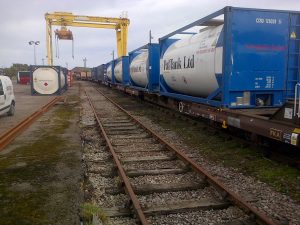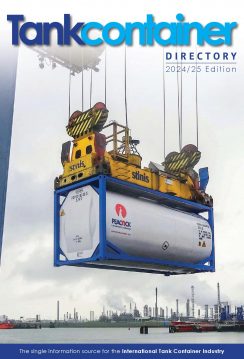With a splash of soda, or perhaps alone on the rocks, whisky is served to the consumer in a glass. An ISO tank container helps get it there, James Graham discovers
Whisky is a commodity moved in food grade IM-102 portable tanks (International IMO Type 2). These tanks transport materials such as whisky and alcohols, some corrosives, pesticides, insecticides, resins, industrial solvents and flammables with flash points ranging from 327oF (164oC) to 1407oF (607oC). These containers are also commonly used for the transport of non-regulated materials such as food-grade commodities. Capacities are normally in the range of 5,000 to 6,300 gallons/ 22,730 to 28,640 litres. They are built to withstand lower maximum allowable working pressures ranging from 14.5psig (1.0 bar) to
24.4 psig (1.75bar). Exporters favour 20ft ISO tank containers because of the heavy nature of the cargo. ISO tank containers containing whisky must make use of heavy gauge wire seals and approved padlocks to restrict access to discharge valves. Some distillers require dedicated tanks to ensure that only one spirit type is filled into certain tanks. For example, a tank used to transport a ‘peated’ whisky might affect the flavour of a ‘non-peated’ whisky. By law, Scotch whisky must be distilled and matured for a minimum of three years, although in reality maturation periods often exceed that. Because of this long production process, the importance of maintaining spirit character and quality during bulk transport must be fully understood and respected
To read the rest of this article please follow the link below and subscribe to the magazine.
https://www.tankcontainermedia.com/subscribe/ October 21, 2015
Whisky is a commodity moved in food grade IM-102 portable tanks (International IMO Type 2). These tanks transport materials such as whisky and alcohols, some corrosives, pesticides, insecticides, resins, industrial solvents and flammables with flash points ranging from 327oF (164oC) to 1407oF (607oC). These containers are also commonly used for the transport of non-regulated materials such as food-grade commodities. Capacities are normally in the range of 5,000 to 6,300 gallons/ 22,730 to 28,640 litres. They are built to withstand lower maximum allowable working pressures ranging from 14.5psig (1.0 bar) to
24.4 psig (1.75bar). Exporters favour 20ft ISO tank containers because of the heavy nature of the cargo. ISO tank containers containing whisky must make use of heavy gauge wire seals and approved padlocks to restrict access to discharge valves. Some distillers require dedicated tanks to ensure that only one spirit type is filled into certain tanks. For example, a tank used to transport a ‘peated’ whisky might affect the flavour of a ‘non-peated’ whisky. By law, Scotch whisky must be distilled and matured for a minimum of three years, although in reality maturation periods often exceed that. Because of this long production process, the importance of maintaining spirit character and quality during bulk transport must be fully understood and respected
To read the rest of this article please follow the link below and subscribe to the magazine.
https://www.tankcontainermedia.com/subscribe/ October 21, 2015
You currently do not have access to this article, please login or register to read more.
Login to read more






